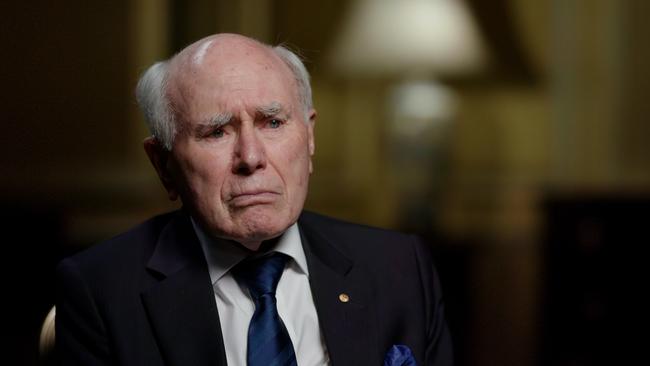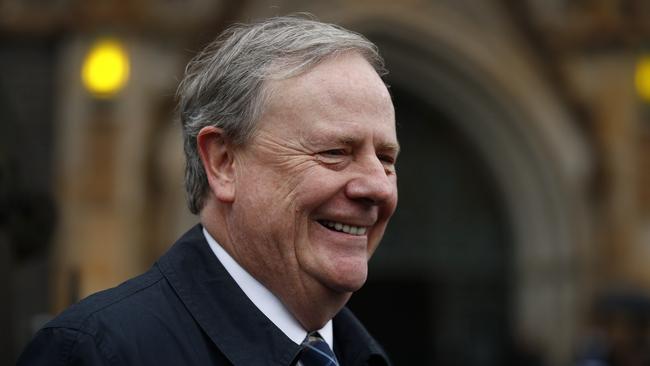
The fund, which now manages more than $256bn across a suite of funds for the federal government, has reported earnings of 9.1 per cent for the year, bringing its 10-year average annual return to 8.3 per cent – comfortably exceeding its target mandate of 6.9 per cent over the period.
It had recorded average annual returns of 7.7 per cent since it started in 2006, above its target return for the period of 7 per cent.
Since it started with seed capital of $60bn from the government’s sale of shares in Telstra, the Future Fund’s investments have grown its assets by almost four times, to $225bn.
The performance and the fund’s emergence as a leading sovereign wealth fund are in no small measure due to the fact that former prime minister John Howard and treasurer Peter Costello deliberately set it up at arm’s length from government.
They set up a structure which would head off any opportunity for the politicians of the day to put their hands in its pocket for political gains and pork barrelling.
The fund is required to invest through external managers and has other restrictions preventing it from having too much exposure to any one asset.
Some of its success must be attributed to the work of Costello, who shepherded through the enabling legislation and protected its independence during his decade years as chair which ended when he stepped down this year.
The success of the Future Fund – in its returns and its governance structure – has resulted in successive governments handing new tasks to its board of guardians.
Outside of the fund, the board manages $64bn worth of funds including the Medical Research Future Fund, the Aboriginal and Torres Strait Islanders Land and Sea Future Fund, the Future Drought Fund, the Disaster Ready Fund, DisabilityCare Australia Fund and, most recently, the Housing Australia Future Fund, now fully invested.
In recent years the fund has also issued a number of discussion papers about the changing global investment climate.
Releasing the results, chief executive Raphael Arndt said they had come after “the changes in the investment environment and the resurgence of geopolitical risks” which the fund has been warning for several years have come about.

The fund’s view of the investment outlook had seen it turn over the full value of its investment portfolio “to align the fund with our revised thinking”, with $50bn of the change made in the past year alone.
In short, the fund’s independence from political interference which has allowed it to develop its independent approach to investing has paid off.
Dealing with the bad news on the economic growth front, Treasurer Jim Chalmers welcomed the fund’s strong returns which he said were delivered “against the backdrop of global uncertainty and volatility”.
“The fund has been a successful and important institution for a long time now and we’re focused on ensuring it can continue to deliver these strong returns,” he said.
He said the government had “refreshed and renewed the fund board” with appointments such as former minister Greg Combet, who took over as chair in June, and other new board members including company director Nicola Wakefield Evans and the former CEO of QSuper Rosemary Vilgan.
He then added an interesting comment. “We’re considering how the fund can maximise its role into the future in a way that maintains its independence and its commercial focus.”
The comments allow for a wide range of options for what the government might do.
There has been fierce debate this week about the importance of the independence of the Reserve Bank in the wake of the Treasurer saying interest rates were “smashing the economy”.
The comments and others from ministers that the RBA should not “go too far” in keeping rates higher were seen as the government putting pressure on the bank to cut rates sooner than later.
Chalmers has sought to argue that he was not pressuring the bank but was “telling it like it is” about the state of the economy.
The independence of the Reserve Bank has been hard fought under successive treasurers and governors and is essential for the credibility of monetary policy, no matter how unpalatable it is to the electorate at times.
Chalmers’ comments on the Future Fund imply there may be some changes ahead in legislation.
The thing to watch is how the fund will change under the chairmanship of Combet, a former head of the ACTU, former Labor minister and an advocate of the need for action on climate change and energy transition.
Combet was chosen as the inaugural chair of the Albanese government’s Net Zero Agency which got off the ground last year.
He makes no secret of his belief in the importance of significant capital investments being made to back the energy transition.
Releasing the Future Fund results, Combet said he would focus on “investment opportunities in the energy transition”.
He said he had been impressed with the fund’s investments in infrastructure assets such as airports, a major port, renewable energy, and telecoms and data centres. “These are important investments in Australia’s future,” he said. “Building on these will be a priority for me, particularly given the investment opportunities in the energy transition.”
He noted that “further developing (the fund’s) ESG capabilities, in particular in relation to climate risks and opportunities, is also a focus for the board”.
Asked for detail, he said there was significant capital investment needed in Australia in sectors such as renewable energy generation, battery storage, and investment in new transmission lines.
There is no doubt Combet’s view when it comes to investing in the energy transition aligns with that of the Albanese government.
Combet was at pains to say any investments in the sector made by the fund would need to be done “provided the appropriate risk adjusted returns are available”.
Just how the Future Fund and its board of guardians manages its independence in the years ahead and how it deploys new capital will be watched closely.
Retaining its independence from government will be key if it wants to invest in these national energy transition projects while also delivering strong returns.





If it does anything, the Future Fund’s strong earnings results for the year to the end of June highlight the importance of its independence from government.